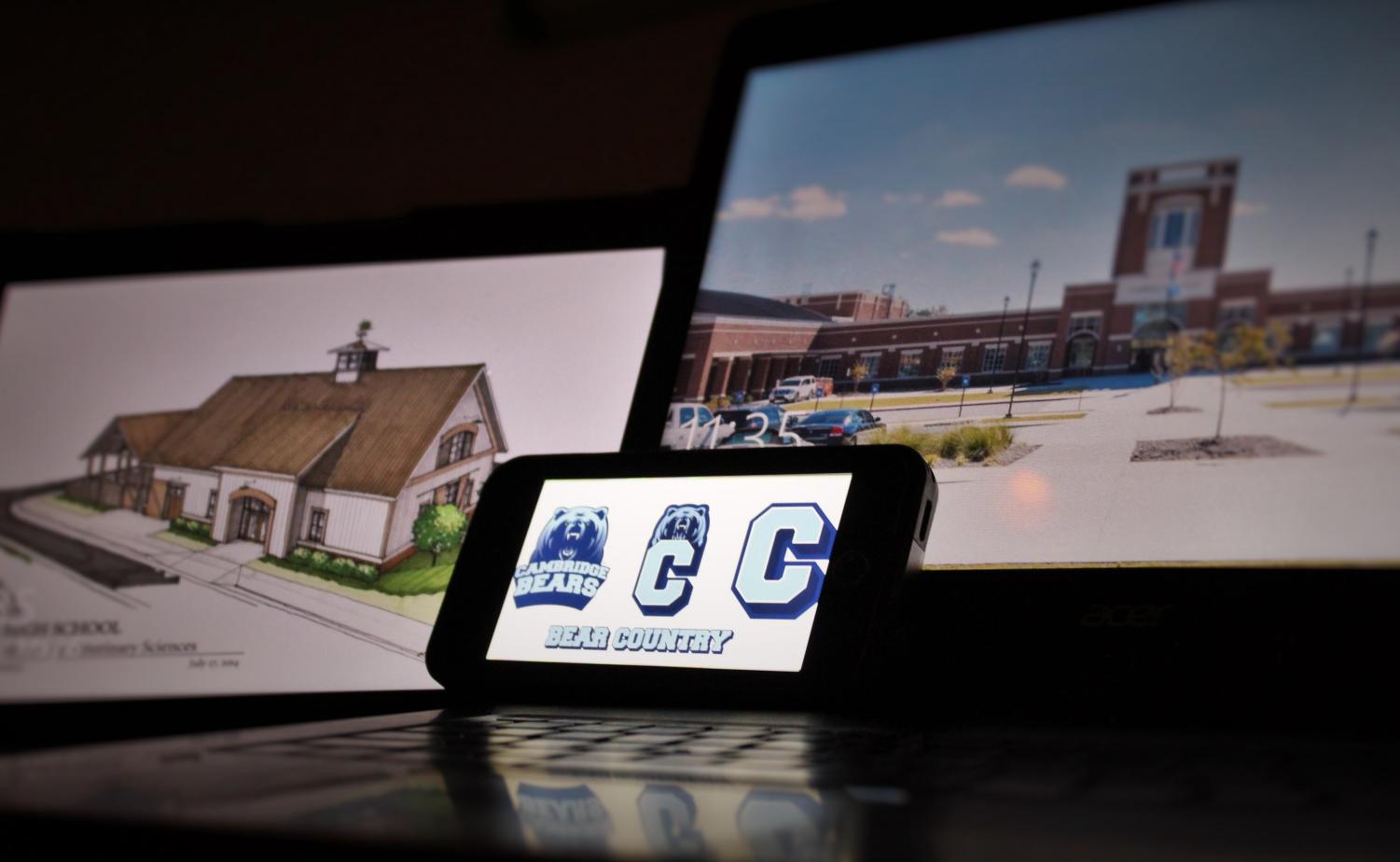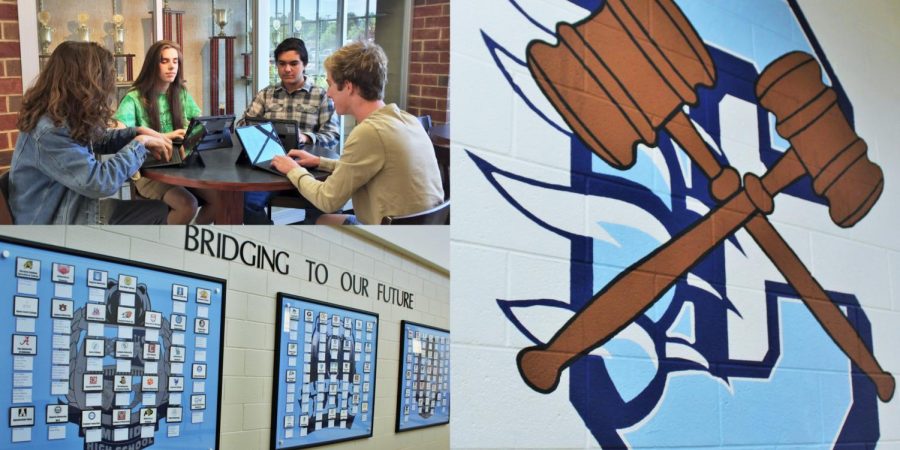Day 3: Tech & Cambridge
Day 3 of our enterprise story, "The New Normal: How Technology is Changing the Cambridge Experience"
May 15, 2018
Dear readers,
This year, when the editors and I sat down to talk about what to write an enterprise story on, we realized just how many of our ideas revolved around technology.
Technology has become ingrained in everyday life, and, consequently, it has become just as prevalent and influential within schools.
After we got to talking, the editors and I realized that there were a number of facets of the high school experience that had been shifted one way or another by technology integration, whether that be a change in social interaction and relationships, career readiness, quality of learning, or anything else.
Because of this, we saw that it would be fitting to write a whole series of stories surrounding the question of how technology has influenced the formation of the modern high school experience, more specifically, here at Cambridge.
We hope these stories serve not only to educate people about technology’s new place in schools, but to draw attention to both its intended and unintended effects.
Thank you,
Greer Spradling
Editor-in-Chief of The Bear Witness
Opinion and A&E Editor Daniel Jimenez and Aaron Stephens
Are Cambridge’s students using technology to fully prepare for the workforce?
Part 4: The 21st Century Workforce: Preparing for the Future of Jobs
Are Cambridge’s students using technology to fully prepare for the workforce?
Technology plays a big role in our world today, as it has become a commonplace feature in our everyday offices, businesses, and classrooms.
The use of it in classrooms by students around the country has been a constant force. From checking emails to completing assignments, the online world has become crucial to today’s learning.
All of this has come to beg the question the following question: Are students at Cambridge using technology to fully prepare for college and the workforce?
Thomas Washburn teaches law and justice, which is a course of study under the umbrella of career tech. He and other teachers in the department focus on preparing students for specific career paths after they’ve left school.
Washburn said he believes students’ Microsoft Surfaces get the job done, and can teach students simple skills like checking and writing emails, along with using the Google web-based editing programs such as Google Docs and Google Sheets, Google’s version of Microsoft Excel.
“Google Sheets is a huge time saver for me in preparation for a class,” said Washburn.
The school is currently providing students with Microsoft Surface Pro tablets. Although these tablets seem to be working out for the students as of now, the school is looking to upgrade to touchscreen Dell laptops in about two years.
“I never really liked using the Surfaces,” said freshman Nnamdi Nwajide. “It would be interesting getting new laptops.”
Marketing teacher Pam Masinko’s classes typically use Microsoft Excel, Word, and PowerPoint. She said she feels it is important to know the workings of all three programs.
Throughout the three-year marketing pathway, students become certified with Microsoft Word and Excel. Excel is a spreadsheet-based program that makes it easier for users to keep track of budgeting and spending.
The marketing classes also use Venngage, Sparkpage, and Canva. These are softwares that help with infographics, storytelling, and graphic design.
Masinko said that technology is definitely changing the game from a marketing perspective, as evident by her recent visit to the Mercedes-Benz stadium.
Masinko took the trip with her third year marketing class and learned about how the Atlanta Falcons and Atlanta United have completely different clientele than each other. They also learned that with a push of a button, both teams can change all the advertisement screens in the stadium to reflect their individual clientele.
Masinko says she believes technology is enveloping the business world, as well as making students’ lives both easier and more focused.
Masinko said that a downside of this integrated technology has been the fact that students have become so attached to their phones, which are like compact computers inside of their pockets.
“It’s a lot easier for them to lose focus when they have the technology,” she said.
Masinko often tells her students to use the desktops that are located in her classroom, but students are allowed to use their Surfaces should they feel the need for them.
With the integration of both laptops and desktops into the daily lives of students, a blueprint has been delivered to aid students on the basic layout of computers.
This will assist students in becoming more comfortable and knowledgeable in how the office environment works for years and years to come.
“Front and Center”: Technology’s Place in the Classroom and Beyond
Opinion: Our third and final guest column out of three to come.
There is an estimate that 65 percent of kids entering primary school today will have jobs in the future that are currently non-existent.
Whether this statistic is accurate or remotely in the realm of possibility, it warrants a conversation and a further examination for educators on the current educational structure and approach.
As educators in the present, we must ask ourselves what can be done to prepare our kids for the world of these already impending careers, as we aren’t just producing a group of isolated thinkers.
We’re sculpting a diverse labor force that’ll tackle some unknown terrains for years to come.
Education must change alongside this rapidly changing job market and, historically, this is what the field of education has always been asked to do.
The Cold War brought upon an era of schools funneling more of their time and energy into STEM than anything else, as it helped to fuel the nuclear war and space-race machine.
The Cold War was just one of the many times our society has asked us to shift our focus of educating students to preparing students for the requirements of their in-demand jobs.
With that in mind, I believe that this era of technology we are living in is no different. The incorporation of tech in the classroom is vital for preparing kids to be successful in the future.
While I would love to believe that the study of Chinese dynasties and President Theodore Roosevelt will prepare my students for their careers in medicine, law, or any other field, (in addition to just being functional members of society), I do understand that the skills I am teaching them through this content and technology is what will most affect them in the long term.
Critical thinking, writing, questioning the reliability of information, and examining information from multiple perspectives are all vital for the courses I teach, but in addition, technology is a core component of how I expect my kids to engage in the content and skills practiced in my classroom.
These are skills and content that can connect them to a multitude of marketable skills for their educational and occupational careers ahead.
While there will always be jobs that don’t require these skills of “creative technological problem solving,” there will be jobs that previously could do without them that will require them.
(Look at the teaching profession!)
We are expected to engage our students with technology by using a learning management system, like Google Classroom or OneNote, because it’s not good enough anymore to just have a million handouts or even just teach out of a textbook.
This is not only because so much better material is out on the web, but also because our students speak a different language and even engage with one another so differently than we did back in the day.
Speaking of students, it never ceases to amaze me how my students manage to be connected to all of the technology through social media, “Fortnite”, “Candy Crush”, (or whatever else you might find yourself wrapped up in), and yet, they can’t work on a Google Document.
My kids can put their face on a meerkat, but they can’t convert a Word document into a PDF file.
Many kids know how to use the technology that they find most important and convenient to them, like games or new selfie filters, but could care less about testing out new, impactful technology that could change the way they engage with information or classroom materials.
I just feel that they are constantly on an escalator that stops working and are just too paralyzed to walk up the stairs, as they’ve just given up on the issues of educational-based technology.
(I try a bunch of different things to see what works, but all they do is say “it doesn’t work.”)
Kids these days also have no idea how good they have it in terms of the opportunities to creatively engage with technology on a daily basis.
At the Baltimore-area school where I previously taught, we didn’t have computer labs or anything remotely close to one-on-one technology. We had some laptop carts filled with super outdated computers that had missing keys and broken screens.
All of this and more has made me feel that the students of this generation have lost that innate curiosity of new technology. They are a generation that had the luxury of “always having it.”
That “innate curiosity of new technology” has, personally, always been with me way before I started elementary school, as technology just fascinated me from a young age.
No matter if they were new computer programs, the internet, or any other new form of technology, I would always be the first in our household to use them.
From using my dad’s dinosaur piece of tech that was his work beeper to taking my motorized toys apart, (poor Tickle-Me-Elmo), and typing up my first school project on the state of Kansas on our first computer, (one of the first mass-produced Apple computers), I was just never afraid to tinker around and figure out how tech worked without manuals or instructions.
I just needed to discover it all on my own.
While I know that many would say that technology has enabled our kids to be this way, I do think that technology could potentially make them much more independent and self-reliant.
Now, for our sake as educators, we can’t keep pretending that we live in a world where we use chalkboards and an abacus. (I think if you ask Mr. Bordas where he stands on this, he’ll probably say he wouldn’t mind bringing back the chalkboards and reflecting on a simpler time.)
When it comes to education, we are on the frontlines of it and must be flexible and comfortable with changing alongside it.
When our world changes, we have to change with it as well.
Just take a look at the cyber terrorism we have to combat now, while also balancing free press, free speech, and the free flow of information.
This is where I think we, as educators, can have an impact on our students. Our job is to equip kids with the capacity to learn in different ways, to adapt to different environments and to formulate interpersonal skills. This gives us a special space in education to play a vital and important part in this impact.
As such, we must make sure our kids aren’t just trained to sit in front of a computer, but trained to engage and communicate.
We need them to work with others, listen, express ideas, and form arguments, which are things that a computer can’t replace or replicate.
While on this subject, there are folks from the days of ole’ who say we should forego content (specific information from a content area – like historical facts about presidents in a US History course) and just teach skills of a technological and problem-solving nature.
I personally don’t think this is good for our kids, as content helps them, (and all of us for that matter), understand the world that we are living in. Just being able to look up a fact online doesn’t mean you understand that fact in proper context, which negates the significance of that piece of information.
As Mr. McDearmon once discussed in a professional learning session, content helps us understand the complex and dense reading. The problem of understanding doesn’t come from someone’s ability to read the text, but to add some meaning to the words in that text.
So since reading isn’t going away anywhere soon, I don’t think content’s importance is going anywhere either.
I also believe that, without content, our kids won’t know where problems originate, and as such, their individual solutions.
Without the understanding of these problems or without the study of the past’s solutions or attempted solutions, how can they be expected to come up with new and creative approaches?
Technology is here to stay, but it will continue to morph and transform and, as such, we need to expose our kids to its possibilities and encourage them to explore and experiment with it, for the sake of making learning more interesting, relevant and accessible.
Technology isn’t some new abstract evaluation system that will just be replaced tomorrow.
Instead, it’s going to be what separates those ready to meet the needs and demands of our new global economy, and those who are resistant and unwilling to adapt.
Adaptation is part of what we, as humans, do, and this should be no exception.
Lauren Hall is a social studies teacher who teaches AP World History and AP U.S History and is also the head coach for both swimming and water polo.


